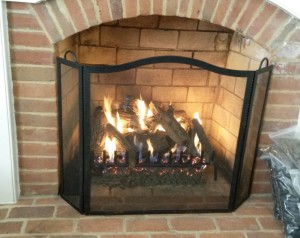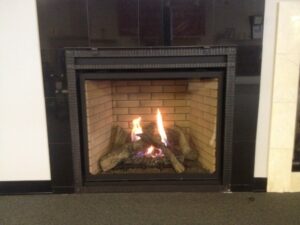The crackling flames, emanating warmth, and comforting aroma of a wood-burning fireplace create an inviting atmosphere that no other heating option can replicate. In this wood fireplace buying guide, you’ll learn how to select and maintain the perfect wood fireplace for your home. Covered topics include the types of wood fireplaces available, design considerations, and safety and maintenance tips, all aimed at helping you make an informed decision when buying a fireplace.
Types of Wood Fireplaces
You have several types of wood fireplaces to choose from, each with advantages and drawbacks. Here’s a brief overview of the most common options.
Traditional Built-In Fireplace
Picture the classic, open-hearth style that has been in use for centuries. These traditional fireplaces can be constructed onsite with classic masonry techniques or factory-built and installed onsite.
Pros:
- Timeless aesthetic
- Various materials available, including brick, stone, and more
- Available in radiant and circulating versions
Cons:
- Less energy-efficient than modern alternatives
- Often used for decoration rather than effective heating
- Requires a dedicated chimney
Wood Fireplace Insert
A wood fireplace insert is a pre-fabricated unit installed in an existing fireplace opening. These self-contained inserts have their own venting system and a firebox, making them ideal if your old chimney structure is damaged and unusable. Fireplace inserts essentially operate like furnaces but with a gorgeous aesthetic. Many even have blowers to circulate heated air through the room.
Pros:
- More efficient and generates more heat than a traditional built-in fireplace
- Reduces drafts and heat loss when not in use
- Easy to install in an existing fireplace
- Lots of design options, including traditional or modern, virtually flush or protruding, simple or dressed up with an elaborate fireplace surround
Cons:
- Not compatible with all fireplace types and sizes
- Potentially constrained designs, depending on the existing fireplace opening
- Less authentic than an open-hearth fireplace
High-Efficiency System
These fireplaces maximize heat output and minimize emissions, making them an eco-friendly choice. High-efficiency systems often have airtight combustion chambers and advanced secondary combustion systems, successfully filling the gap between efficiency and aesthetics in the world of wood-burning fireplaces.
Pros:
- Energy-efficient
- Environmentally friendly
- Heat vents and air intakes facilitate heating large spaces
Cons:
- More expensive upfront
- May require professional installation
Wood-Burning Stove
A freestanding wood-burning stove is a versatile option that can be placed almost anywhere in your home, as long as proper venting is available. These units may be constructed of steel, cast iron, or partially soapstone, with a traditional or modern appearance.
Pros:
- Flexible placement options, including inside an existing fireplace
- Variety of styles, sizes, and log-holding capacities
- Energy-efficient performance with optional blowers available
Cons:
- Requires dedicated venting
- Needs a non-combustible hearth pad or masonry floor
- Doesn’t provide the same ambiance as a built-in fireplace
Wood Fireplace Design Considerations
When buying a wood fireplace, your goal is to add a beautiful addition and a safe, efficient heat source. Here are the factors to consider when choosing the perfect fireplace to suit your home and lifestyle:
- Size: Your fireplace must fit comfortably within the available space and meet your heating requirements. Larger fireplaces provide more heat but may require more fuel and maintenance. Smaller fireplaces may be suitable for compact spaces or rooms requiring supplemental heat.
- Style: Wood fireplaces range from traditional brick and rustic stone to modern, streamlined metal. Consider the overall design of your home and choose a fireplace that complements your decor and personal taste.
- Venting requirements: Proper venting is critical for the safe and efficient operation of any wood-burning fireplace. Assess your existing venting infrastructure or consult a professional to determine if your home can accommodate the necessary venting for your chosen fireplace and installation location.
- Efficiency: More efficient fireplaces save money on heating costs. Look for features such as secondary combustion, airtight combustion chambers, or EPA certification to ensure your fireplace meets environmental standards.
- Convenience features: Additional features enhance your wood fireplace experience and make operation and maintenance more manageable. Look for a built-in ash pan for easy ash removal; air controls to regulate combustion and heat output; glass doors for improved safety and heat retention; or a blower system to distribute heat more evenly.
- Hearth and surround: These features significantly impact your wood fireplace’s safety and appearance. Ensure the hearth and surround materials are non-combustible and heat-resistant. Then, consider their design and colors to complement your fireplace style and enhance the room’s aesthetic.
Wood Fireplace Safety & Maintenance
Proper installation, routine maintenance, and correct day-to-day use are essential for keeping your wood fireplace clean, safe, and functional for years to come. Here’s what fireplace experts recommend:
- Rely on a professional for wood fireplace installation.
- Install a properly-sized chimney to prevent backdrafts and smoke buildup.
- Use a spark arrestor to prevent embers from escaping the chimney.
- Install a carbon monoxide detector near the fireplace.
- Season firewood properly for optimal burning efficiency.
- Keep flammable materials away from the fireplace.
- Never leave a burning fire unattended. Extinguish it completely before leaving the house or going to bed.
- Clean the fireplace and remove ashes after each use.
- Inspect and clean the chimney at least annually to prevent creosote buildup.
- Clean the glass doors (if applicable) with a fireplace glass cleaner.
- Check and replace gaskets as needed.
- Inspect and maintain the fireplace’s ventilation system to ensure proper airflow.
- Trim overhanging branches and remove debris around the chimney to prevent blockages and fire hazards.
Contact Bromwell’s The Fireplace People
A wood-burning fireplace adds warmth, ambiance, and traditional appeal to any home. Once you determine that a wood fireplace is perfect for your living space, contact Bromwell’s The Fireplace People at (703) 207-9800 for more information. Our family-owned and operated business has been installing wood fireplaces in Washington, DC, for over 150 years.


